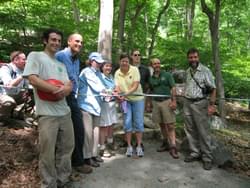




Partners work to develop volunteers skills to improve heavily-used sections of the Appalachian National Scenic Trail.

The initial development of the Appalachian National Scenic Trail (AT) occurred in Bear Mountain State Park in New York State in 1923. Over the years, the trail has experienced considerable use and sections have been realigned. Today, more than 100,000 hikers a year and day users traverse the section from the base of Bear Mountain to the top, making it the most highly used section of the AT. As a result sections of the trail have been over utilized, resulting in erosion, widening of the trail and general degradation of the trail experience.
In response to these concerns, a partnership between the New York-New Jersey Trail Conference (NYNJTC), Appalachian Trail Conservancy (ATC), Palisades Interstate Park Commission (PIPC), New York State Office of Parks, Recreation and Historic Preservation (OPRHP) and the National Park Service (NPS) was established to reconstruct and relocate sections of the AT for long-term sustainability and an improved trail experience.
This past Trails Day marked a significant milestone in the rehabilitation/relocation of the AT with the dedication of the new section of trail from the Bear Mountain Inn to the top of Bear Mountain within Bear Mountain State Park. This one mile trail up the side of the mountain and through a boulder field was a design and engineering achievement of trail construction. This construction effort currently features over 700 hand-hewn granite steps and one mile of tread way supported by stone crib walls. Each step and wall stone is split and shaped from rocks on site and maneuvered into place either by hand or via a series of overhead cables rigged up in the surrounding trees. With each step measuring 4-5 feet long, weighing in at around 1,000 pounds, and in need of moving distances of up to 300 feet without the aid of motorized equipment, the Trail Conference has sought out professional trail builders from all over the country to lead the construction effort and train hundreds of volunteers.
From 2006-2010, volunteers from The NYNJTC, ATC, Student Conservation Association (SCA), Rockland County Americorps, and the Boy Scouts of America traveled to Bear Mountain to receive free training as part of the Trail Conference's innovative Trail University program. This program was founded on Bear Mountain at the start of this project in 2006 and enabled the Trail Conference to provide free workshops for volunteers seeking to learn both basic and advanced trail building techniques. These workshops provided for a revival of the masonry skills utilized in the 1930’s by the Civilian Conservation Corps when constructing much of Harriman State Parks roads, walls, and buildings.
The first portion of the relocated trail was opened on June 5th, 2010; by this time, over 700 individuals had volunteered over 25,000 hours of aid in helping build the most technically constructed stretch of the entire Appalachian Trail and the largest trail building project in the history of the New York-New Jersey Trail Conference.
The trail blends in with the surrounding environment with little evidence that new construction actually occurred. The design maximizes the attributes of the terrain and encourages the large number of trail users to stay on the trail. The success of the project depended on the cooperation and participation of all the partners. The end product was a sustainable trail that will last for generations.
A partnership agreement, signed in 2008, defined the purpose and scope of the project, schedule and administration, and the roles and responsibilities. The Project Team functioned cooperatively in the planning and development of the trail system, with each partner having specific responsibilities:
NY-NJ Trail Conference – As project managers, the NY-NJ Trail Conference was responsible for the overall coordination of the project; recruitment, training and supervision of volunteers; design and layout of non-AT trail segments; and construction.
Appalachian Trail Conservancy – the ATC was responsible for the design, layout and overall construction review of the AT to insure the AT standards were being met; and the recruitment of volunteers from a national and wider regional level.
National Park Service – NPS provided support and assistance to the Project Team members in accomplishing their functions.
PIPC/OPRHP – PIPC/OPRHP was responsible for approving the design and construction elements and signage; environmental review process; and providing heavy equipment support.